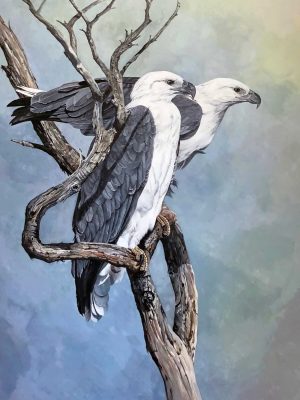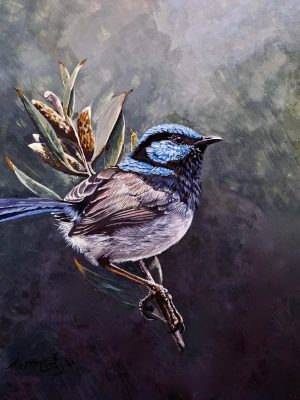Showing all 4 resultsSorted by price: high to low

Print Size: 45cm x 30cm (no matt surround)
The white-bellied sea eagle (Haliaeetus leucogaster), also known as the white-breasted sea eagle, is a large diurnal bird of prey in the family Accipitridae. Originally described by Johann Friedrich Gmelin in 1788, it is closely related to Sanford's sea eagle of the Solomon Islands, and the two are considered a superspecies. A distinctive bird, the adult white-bellied sea eagle has a white head, breast, under-wing coverts and tail. The upper parts are grey and the black under-wing flight feathers contrast with the white coverts. The tail is short and wedge-shaped as in all Haliaeetus species. Like many raptors, the female is slightly larger than the male, and can measure up to 90 cm (35 in) long with a wingspan of up to 2.2 m (7.2 ft), and weigh 4.5 kg (9.9 lb).
This is an archival print. To view our limited edition prints click here.
*Price includes postage anywhere within Australia.

Print Size: 20cm x 20cm (with matt surround)
The superb fairywren (Malurus cyaneus) is a passerine bird in the Australasian wren family, Maluridae, and is common and familiar across south-eastern Australia. The species is sedentary and territorial, also exhibiting a high degree of sexual dimorphism; the male in breeding plumage has a striking bright blue forehead, ear coverts, mantle, and tail, with a black mask and black or dark blue throat. Non-breeding males, females and juveniles are predominantly grey-brown in colour; this gave the early impression that males were polygamous, as all dull-coloured birds were taken for females. Six subspecies groups are recognized: three larger and darker forms from Tasmania, Flinders and King Island respectively, and three smaller and paler forms from mainland Australia and Kangaroo Island.
This is an archival print. To view our limited edition prints click here.
*Price includes postage anywhere within Australia.

Print Size: 25cm x 25cm (with matt surround)
The Southern fairy prion is a member of the Pachyptila genus, and along with the blue petrel makes up the prions. They in turn are members of the Procellariidae family, and the Procellariiformes order. The prions are small and typically eat just zooplankton;[2] however as a member of the Procellariiformes, they share certain identifying features. First, they have nasal passages that attach to the upper bill called naricorns. Although the nostrils on the albatross are on the sides of the bill. The bills of Procellariiformes are also unique in that they are split into between 7 and 9 horny plates. They produce a stomach oil made up of wax esters and triglycerides that is stored in the proventriculus. This is used against predators as well as an energy rich food source for chicks and for the adults during their long flights.[3] Finally, they also have a salt gland that is situated above the nasal passage and helps desalinate their bodies, due to the high amount of ocean water that they imbibe. It excretes a high saline solution from their nose.
This is an archival print.
*Price includes postage anywhere within Australia.

Print Size: 100 cm x 80 cm
With its combination of royal-blue plumage on its upperparts contrasting with orange on its underparts, the Azure Kingfisher is one of the smallest and most dazzling kingfishers in Australia. This diminutive species inhabits the vegetation beside waterways and other wetlands, where it often perches on low, overhanging branches, searching for its prey of fish, crustaceans and aquatic insects, captured by shallow plunging into the water. Anglers on lonely rivers are sometimes surprised to find an Azure Kingfisher perched quietly on their fishing rods instead of a branch.
This is an archival print. To view our limited edition prints click here.
*Price includes postage anywhere within Australia.
